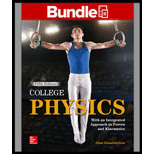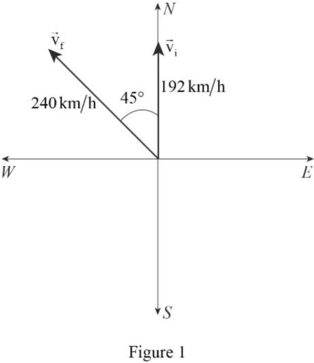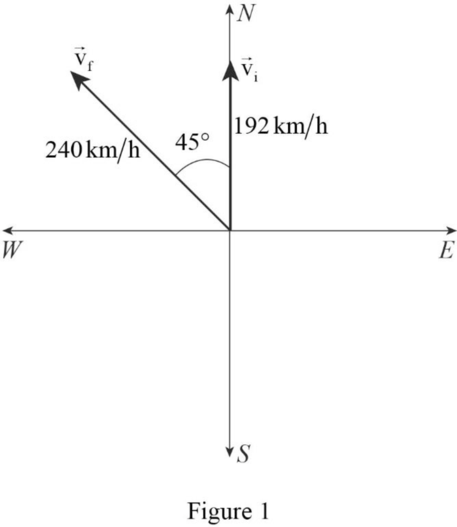
Concept explainers
(a)
To draw the initial and final velocity vectors.
(a)
Answer to Problem 49P
The diagram of the initial and final velocity vectors is

Explanation of Solution
Velocity is rate of change of displacement of an object. It is a vector and has both magnitude and direction. The initial and final velocity vectors of the person is drawn in figure 1.

In figure,
Conclusion:
Therefore, the initial and final velocity vectors is drawn in figure 1.
(b)
The change in velocity.
(b)
Answer to Problem 49P
The change in velocity is
Explanation of Solution
Take the positive x-axis to be directed along west direction and the positive y-axis to be directed along north direction.
Write the expression for the initial velocity vector.
Write the expression for the x component of
Here,
Write the expression for the y component of
Here,
Write the expression for the final velocity vector.
Here,
Write the expression for the x component of
Here,
Write the expression for the y component of
Here,
Write the equation for the x-component of the change in velocity.
Here,
Put equations (I) and (III) in the above equation.
Write the equation for the y-component of the change in velocity.
Here,
Put equations (II) and (IV) in the above equation.
Write the equation for the magnitude of the change in velocity.
Here,
Write the equation for the direction of the change in velocity.
Here,
Conclusion:
Put equations (V) and (VI) in equation (VII) to find
Put equations (V) and (VI) in equation (VIII) to find
The negative sign shows that the angle is clockwise or the change in velocity is at
Therefore, the change in velocity is
(c)
The average acceleration during the trip.
(c)
Answer to Problem 49P
The average acceleration during the trip is
Explanation of Solution
Write the equation for the magnitude of the average acceleration.
Here,
Conclusion:
Substitute
The direction of acceleration will be the same as that of change in velocity.
Therefore, the average acceleration during the trip is
Want to see more full solutions like this?
Chapter 3 Solutions
COLLEGE PHYSICS (LOOSELEAF)-W/CONNECT
 College PhysicsPhysicsISBN:9781305952300Author:Raymond A. Serway, Chris VuillePublisher:Cengage Learning
College PhysicsPhysicsISBN:9781305952300Author:Raymond A. Serway, Chris VuillePublisher:Cengage Learning University Physics (14th Edition)PhysicsISBN:9780133969290Author:Hugh D. Young, Roger A. FreedmanPublisher:PEARSON
University Physics (14th Edition)PhysicsISBN:9780133969290Author:Hugh D. Young, Roger A. FreedmanPublisher:PEARSON Introduction To Quantum MechanicsPhysicsISBN:9781107189638Author:Griffiths, David J., Schroeter, Darrell F.Publisher:Cambridge University Press
Introduction To Quantum MechanicsPhysicsISBN:9781107189638Author:Griffiths, David J., Schroeter, Darrell F.Publisher:Cambridge University Press Physics for Scientists and EngineersPhysicsISBN:9781337553278Author:Raymond A. Serway, John W. JewettPublisher:Cengage Learning
Physics for Scientists and EngineersPhysicsISBN:9781337553278Author:Raymond A. Serway, John W. JewettPublisher:Cengage Learning Lecture- Tutorials for Introductory AstronomyPhysicsISBN:9780321820464Author:Edward E. Prather, Tim P. Slater, Jeff P. Adams, Gina BrissendenPublisher:Addison-Wesley
Lecture- Tutorials for Introductory AstronomyPhysicsISBN:9780321820464Author:Edward E. Prather, Tim P. Slater, Jeff P. Adams, Gina BrissendenPublisher:Addison-Wesley College Physics: A Strategic Approach (4th Editio...PhysicsISBN:9780134609034Author:Randall D. Knight (Professor Emeritus), Brian Jones, Stuart FieldPublisher:PEARSON
College Physics: A Strategic Approach (4th Editio...PhysicsISBN:9780134609034Author:Randall D. Knight (Professor Emeritus), Brian Jones, Stuart FieldPublisher:PEARSON





